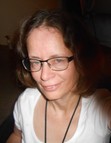Start with Action…or Not

This topic surfaced for me while looking at The Writer article by Roberta Fleming Roesch called Guideposts to the First Two Pages (pp. 182-184). “Start with action” is common writing advice. As commonly, it’s also misinterpreted.
Hollywood’s influence creates this interpretation. Many movies open with a physical action scene. A character jumps from a plane, a gunfight, a monster chases a girl.
That’s where movies shouldn’t influence book writing. Movies open with an action scene to hook the men. This was from a newspaper article I read many years ago, when movies were actively courting young men. Men are more visually oriented, so actions scenes are designed to engage them immediately.
Not all movies start with a big action scene, but it’s where everyone’s head goes. The problem? A novel’s not a movie.
A movie can only appeal to sight and sound. That visual aspect also makes the viewer absorb what they’re seeing in an instant. A book is read at the reader’s pace, which can vary. Yet, in the Guideposts article, there’s a lot required in the first pages. All without bogging everything down!
Writing the beginning is hard.
Character must be established first. A viewer will enjoy a movie action hero falling out of a plane because it goes by so fast. The visual is also designed to over the top because that’s part of the fun. We also instantly know he’s the main character because of the movie credits with the star’s name.
A book? A physical action scene is disconnected from the reader. This character has not been established; no handy top billing movie star. This makes it hard for the reader to care about this character.
And how do you establish the setting needed for the physical action? It can’t exist in a white room. White room action is worse than talking heads because the writer doesn’t give the reader anything to invest in.
So what does “start with the action” mean?
Depends on the source. And they’re all correct. It’s about “movement.”
When I took Dean Wesley Smith’s Depth class, I started writing a lot more setting into my opening scenes (up from none). My first personal rejection from a professional magazine told me I was missing a hint of the story to come. (They didn’t say that specifically. Instead, they provided a comment that helped me discover that.)
Many writers would interpret this as plot (story events). Nope. Not plot. This is a very small movement, one sentence, or a few words. In a mystery showing a prologue with the murder victim, the writer might say, “George Smith didn’t know this was his final hour.” The reader instantly knows this a mystery.
Another type of movement is the character doing something. Not laying on a bed, contemplating a ceiling fan for five pages (actual book). Again, it needs the hint of the story to come. Janice Hardy has descriptions of when you haven’t done enough movement.
Description is essential in an opening. However, it’s easy to overbalance the description into stagnant because it’s slower paced. In Descriptions They Won’t Skip by Eloise Jarvis (pp. 411-414 and 430), the author suggests adding movement to the descriptions. These aren’t particularly big changes; it might be changing a word or rewording a sentence. A character can have “cascading blonde hair.” Clouds can “skitter” across the sky.
Dialogue also adds movement. In Basic Forms of Writing by Walter S. Campbell (pp. 300-304), he notes that dialogue is about immediacy. Immediacy is another sense of movement.
One of the challenges of advice like “start with the action” is that we want the surety of simplicity. With writing, we don’t get simplicity. The more we learn, the more complexities we find.



